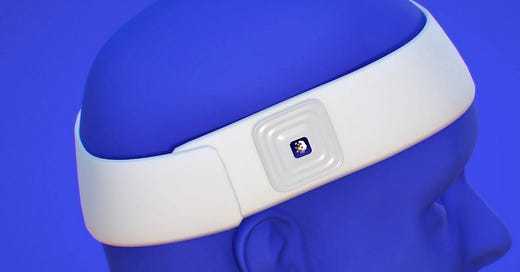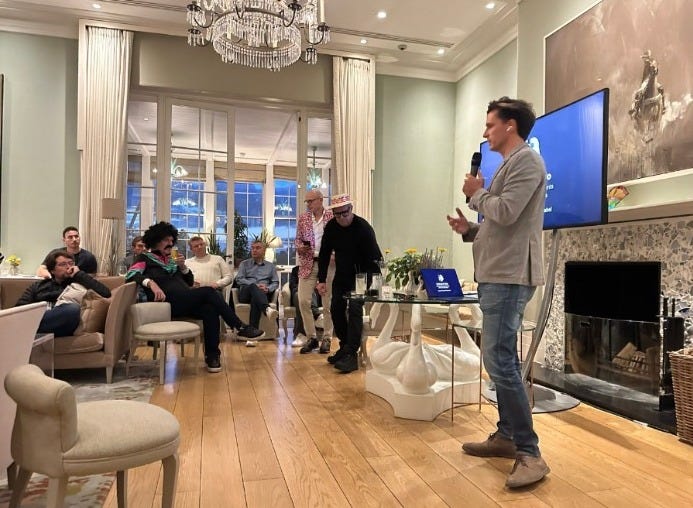Last week, Chris Tottman and I managed to interview Vasco Pedro, the CEO and co-founder of Unbabel and witnessed him demonstrate his new product, Halo.
Halo blows your mind in demo mode, and it absolutely blew away the entire audience at Notion's Founders retreat, where 100 founders gather each year for peer-to-peer sessions.
Halo claimed the spotlight was the highest-rated session of the week.
Here is our interview with Vasco, who kindly made the time to meet with us after…
So Vasco, what is the product, Halo, that everyone is buzzing about?
Halo is a groundbreaking device that allows you to communicate without speaking. It unlocks ‘superhuman’-like capabilities by using advanced Generative AI and a non-invasive neural interface, which translates bioelectrical signals from your brain into words, which can be spoken in your own voice or displayed as text.
What’s the story behind Halo? What was the spark that ignited its creation, and how did it come together?
Well, we created Halo with a vision of taking human communication to the next level. Imagine communicating through thought alone - 7 years ago, when I took the first step on this path, it was a distant dream. But I felt compelled to explore human communication - at its deepest, most ‘meta’ level - by using brain signals. Today, we’ve got to a place where sci-fi is not anymore; it's not only happening, but it's also being used by our first beta customers.
We've seen the technology working in the demo but for the readers that does sound sci-fi & so how does it work?
Halo combines Generative AI with a non-invasive neural interface to turn bioelectrical signals from your brain into language. Sensors embedded in a wristband or headband capture input from your brain, while an earbud delivers real-time output, either delivered as your voice or displayed as text.
We made it non-invasive for comfort and ease because - let’s be honest - most of us would prefer a wearable over having devices planted into our brains!
Ok so no cranial operation is required to access the benefits (!), this is a brain interface like technology but what are the real-world problems you're solving?
It might sound cliche, but communication is really everything. It’s how we connect, share ideas, build relationships, and navigate the world around us. But when communication is limited or impossible, it’s life-limiting.
That’s the challenge we’re taking on with Halo with our beta customers i.e. those with the most to gain - giving a voice to those who can’t speak, such as patients with ALS and those who suffer from ‘locked-in’ syndrome. Halo is currently being piloted across a number of organizations in Portugal and our initial focus is to scale it for those who need it the most.
Beyond medical applications, in the not-so-distant future, we see Halo as a game-changing tool for human augmentation and pushing the boundaries of communication in ways we’ve never seen before. In a sense, it’s like how the invention of the internet transformed how we connect with information, bridging the gap from analogue to digital. Halo is the first giant leap towards communication beyond traditional speech. It’s the breakthrough that redefines how we interact, much like the hybrid car reshaped the journey toward fully electric vehicles.
Halo marks the future of communication—where spoken words aren’t the only way to convey meaning. Watch this space…
Many people get quite emotional when witnessing the demo including me. What makes it so special?
One standout feature is Halo’s ability to give users their own voice. And yes, it's honestly so emotional to witness - when an ALS patient who hasn’t been able to speak with their family in years, can finally communicate using their voice again. The first time it happened when I was there with the patient's family it was incredible. It still gets me every time.
This breakthrough was made possible through our partnership with OpenAI (announced at the UN’s AI for Good Summit) and it allows us to use the latest Voice Engine model to bring this vision to life.
We have the video clip here, it's quite extraordinary:
Now our eyes are dry. What’s the game plan? How do you see it scaling from here?
Our long-term vision is for Halo to be a tool that amplifies human capabilities by addressing real human needs. In essence, it will augment humans through AI and neural interfaces and enable us to communicate beyond any limits we’ve ever known. Ultimately, it’s about transforming how we understand, interact, and truly relate to one another.
Before we wrap up, what’s next for Halo?
We’re excited to continue to partner with the UN’s AI for Good initiative to raise awareness about Halo whilst we scale its clinical trials. We’re also on the hunt for Halo’s first CEO because I believe it's crucial to have dedicated leadership, as Halo embarks on this ambitious, moonshot journey. This is the most exciting part for me, looking for a visionary to partner with our VP of Innovation and brilliant engineers, to take this vision and lead our growth into something truly extraordinary.
That sounds pretty exciting. What type of person are you looking for?
Well, we're just starting the process now, and their background will need to align with our heritage, where hardware and software intersect. But what I really care about is hiring someone who dreams big and is passionately invested in solving the problem at hand - someone who cares so deeply about what they do, it’s to the point where others that don’t care as much might think they’re a bit weird! And someone who has solid entrepreneurial instincts, unafraid to take risks and can hold their own with investors. Whoever it is, the new CEO will be instrumental in shaping Halo’s future.







This can make miracle if used for good!
“I came up with a term after learning about Halo. It’s impressive how it facilitates the evolution of communication and human interactions, opening the door to applications that integrate programming, technology, and production, while also being used in the physical world. These applications operate in a human-techO format, facilitating interactions from human to human.”